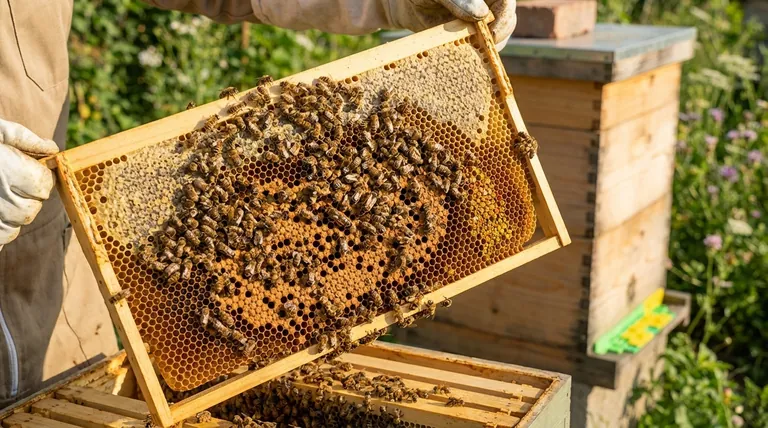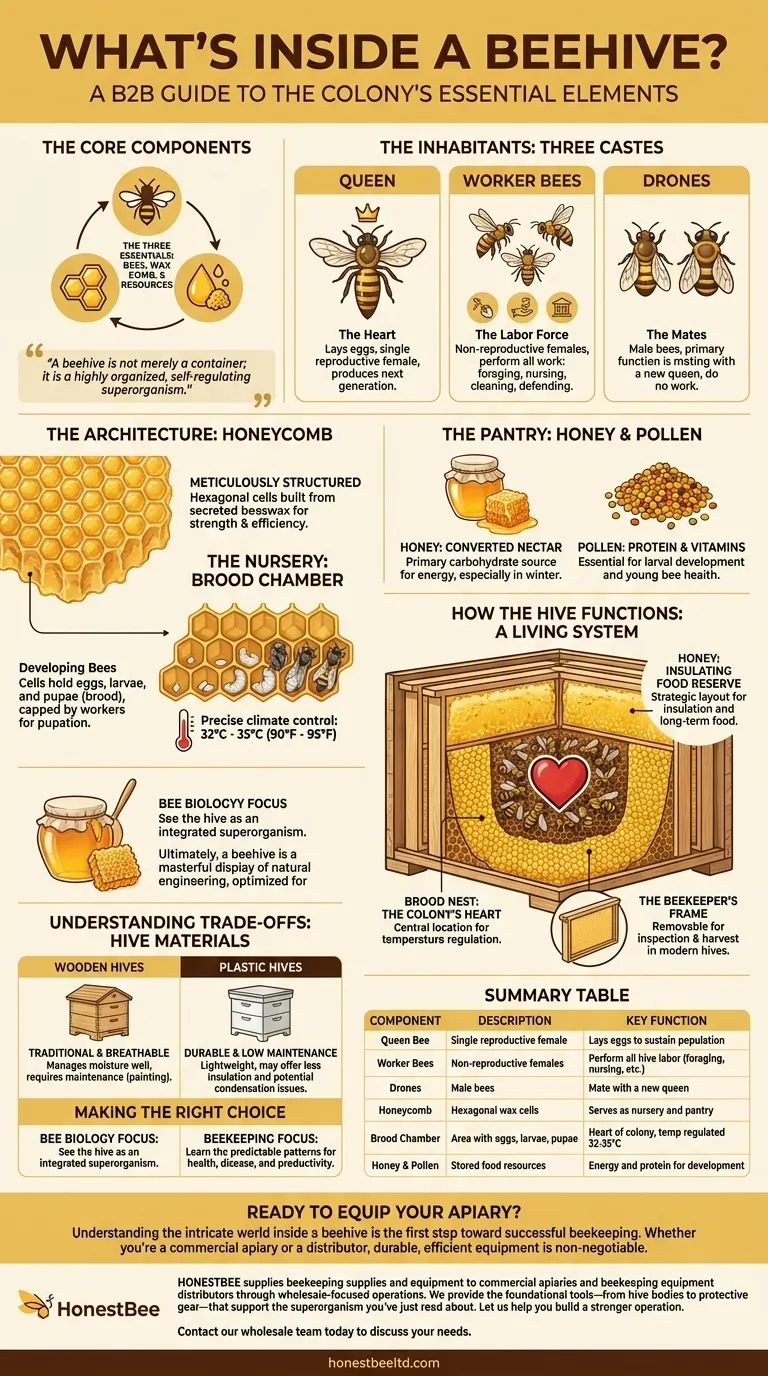At its core, a beehive contains the three essential elements for a colony's survival: the bees themselves, the wax comb they build, and the resources they store. The comb is meticulously structured into hexagonal cells that serve as a nursery for developing bees (brood) and a pantry for storing food sources like honey and pollen.
A beehive is not merely a container; it is a highly organized, self-regulating superorganism. Every component, from the individual bee to the placement of honey, serves a precise function dedicated to the health, growth, and reproduction of the colony.

The Core Components of a Hive
To understand what’s inside a hive, we must look at it as both a population and a structure. Each part is interconnected and vital for the colony's success.
The Inhabitants: Three Castes of Bees
A colony is a complex society with a strict division of labor.
The Queen is the single most important individual. Her sole purpose is to lay eggs, producing the next generation of bees. She is the mother of nearly every bee in the hive.
Worker bees are non-reproductive females that perform all the labor. This includes foraging for nectar and pollen, producing wax, building comb, nursing the young, cleaning the hive, and defending the colony.
Drones are the male bees. Their only job is to mate with a new queen. They do no work in the hive and are often expelled from the colony before winter.
The Architecture: Honeycomb
Honeycomb is the internal structure of the hive, built by worker bees from secreted beeswax.
These wax sheets are formed into a dense array of hexagonal cells. This shape is incredibly strong and efficient, allowing bees to store the maximum amount of resources with the minimum amount of wax.
The Nursery: The Brood Chamber
The cells of the comb are where the next generation is raised. This area is known as the brood chamber.
The queen lays a single egg in each cell. The egg hatches into a larva, which is fed by worker bees until it grows large enough to pupate. The workers then cap the cell with wax, and the pupa develops into an adult bee. This entire collection of eggs, larvae, and pupae is called brood.
The Pantry: Honey and Pollen
Bees use other cells in the comb to store their food.
Honey is converted nectar. It serves as the colony's primary carbohydrate source, providing the energy needed for all hive activities, especially surviving the winter.
Pollen is the bees' source of protein and vitamins. It is essential for feeding the larvae and ensuring the healthy development of young bees.
How the Hive Functions as a Living System
The placement of these components is not random. The bees organize their home with remarkable efficiency to regulate their environment and protect their resources.
The Brood Nest: The Heart of the Colony
The brood is typically located in the central, lower part of the hive. The bees form a cluster around this area to maintain a constant temperature.
Worker bees keep the brood nest between 32°C and 35°C (90°F and 95°F), regardless of the outside temperature. This precise climate control is critical for the healthy development of the young bees.
Resource Storage: A Strategic Layout
Bees typically store their food in a predictable pattern around the brood.
A band of pollen is often stored directly surrounding the brood nest, making it easily accessible for nurse bees to feed the larvae. Above and to the sides of the pollen and brood, the bees store their main supply of honey. This acts as an insulating layer and a long-term food reserve.
The Beekeeper's Frame
In a modern, managed hive, bees build their comb on removable frames.
These wooden or plastic frames allow beekeepers to easily inspect the colony's health, check for the queen, and harvest surplus honey without destroying the hive's structure. This is the primary difference between a beekeeper's hive and a wild colony's nest in a tree cavity.
Understanding the Trade-offs: Hive Materials
While bees create the interior, beekeepers choose the exterior box. The material of the hive body itself—most commonly wood or plastic—presents different considerations for the beekeeper.
Wooden Hives
Wood is the traditional material. It breathes well, helping to manage moisture, but requires more maintenance, such as painting, to protect it from the elements.
Plastic Hives
Plastic hives are durable, lightweight, and require little maintenance. However, they can offer less insulation and may lead to more condensation inside the hive if not managed with proper ventilation. This choice directly impacts the environment the bees must work to control.
Making the Right Choice for Your Goal
Understanding the contents of a hive serves different purposes depending on your interest.
- If your primary focus is bee biology: See the hive as a superorganism where the castes, comb, and stored resources are all integrated parts of a single living entity.
- If your primary focus is potential beekeeping: Recognize that the hive's interior follows a predictable pattern that you must learn to read for signs of health, disease, and productivity.
Ultimately, a beehive is a masterful display of natural engineering, optimized for survival and efficiency.
Summary Table:
| Component | Description | Key Function |
|---|---|---|
| Queen Bee | Single reproductive female | Lays eggs to sustain the colony's population |
| Worker Bees | Non-reproductive females | Perform all hive labor (foraging, nursing, building, cleaning) |
| Drones | Male bees | Mate with a new queen |
| Honeycomb | Hexagonal wax cells | Serves as nursery (brood) and pantry (honey & pollen) |
| Brood Chamber | Area with eggs, larvae, pupae | The heart of the colony, kept at 32-35°C (90-95°F) |
| Honey & Pollen | Stored food resources | Honey provides energy; pollen provides protein for larval development |
Ready to Equip Your Apiary with the Best Supplies?
Understanding the intricate world inside a beehive is the first step toward successful beekeeping. Whether you're a commercial apiary managing hundreds of hives or a distributor supplying the industry, having durable, efficient equipment is non-negotiable for colony health and honey production.
HONESTBEE supplies beekeeping supplies and equipment to commercial apiaries and beekeeping equipment distributors through wholesale-focused operations. We provide the foundational tools—from hive bodies and frames to protective gear—that support the superorganism you've just read about.
Let us help you build a stronger operation.
Contact our wholesale team today to discuss your specific needs and learn how our products can contribute to the success and scalability of your beekeeping business.
Visual Guide

Related Products
- Multi-Functional Sliding Hive Entrance for Beekeeping
- Wholesales Dadant Size Wooden Bee Hives for Beekeeping
- Automatic Honey Flow Beehive 4 Frame Mini Hive for Beekeeping
- Professional Engraved Round Hive Number Tags for Beekeeping
- Wooden Bee Brush with Double-Row Horsehair Bristles
People Also Ask
- What are some alternative strategies to using entrance reducers? Empower Your Bees for Natural Hive Defense
- What is the purpose of placing an object in front of the hive entrance after a move? A Guide to Forced Reorientation
- Why is a smaller entrance size beneficial for a beehive? Boost Hive Defense & Productivity
- How does the sliding design of the entrance reducer benefit beekeepers? Achieve Ultimate Hive Control
- What are the different entrance sizes for an 8 or 10-frame Langstroth hive? A Guide to Seasonal Management



















